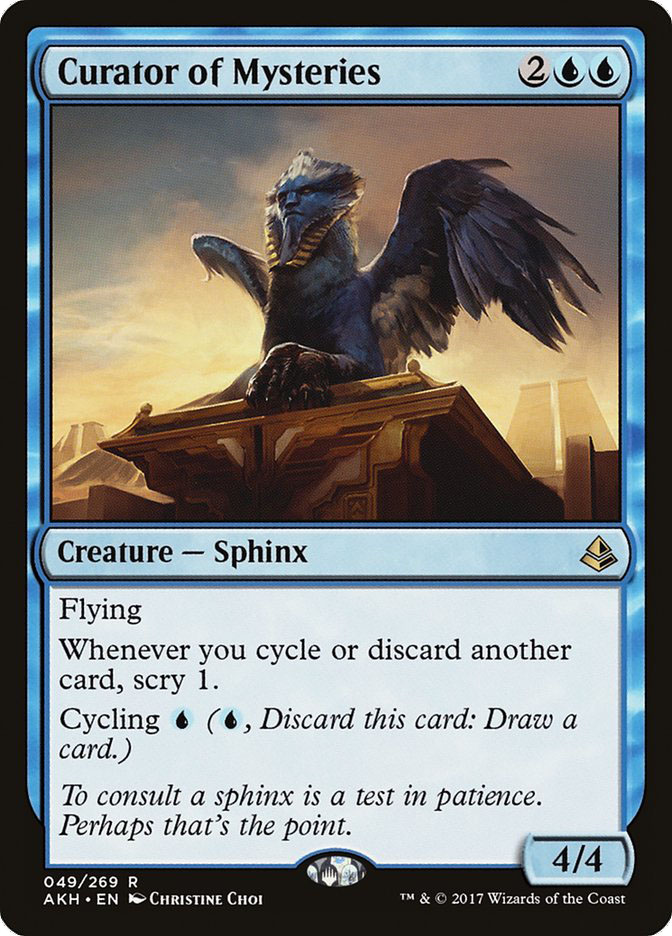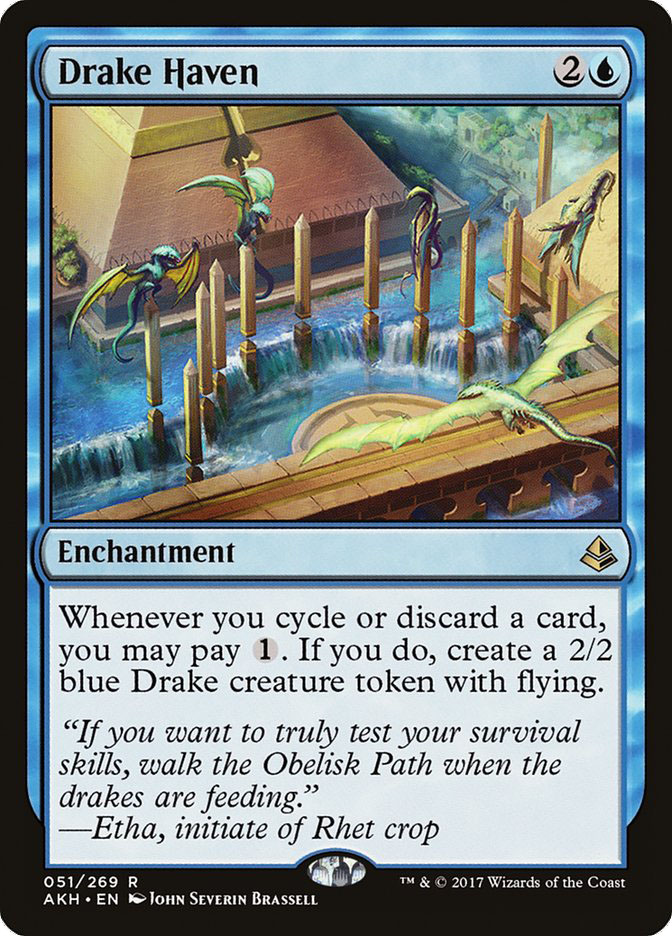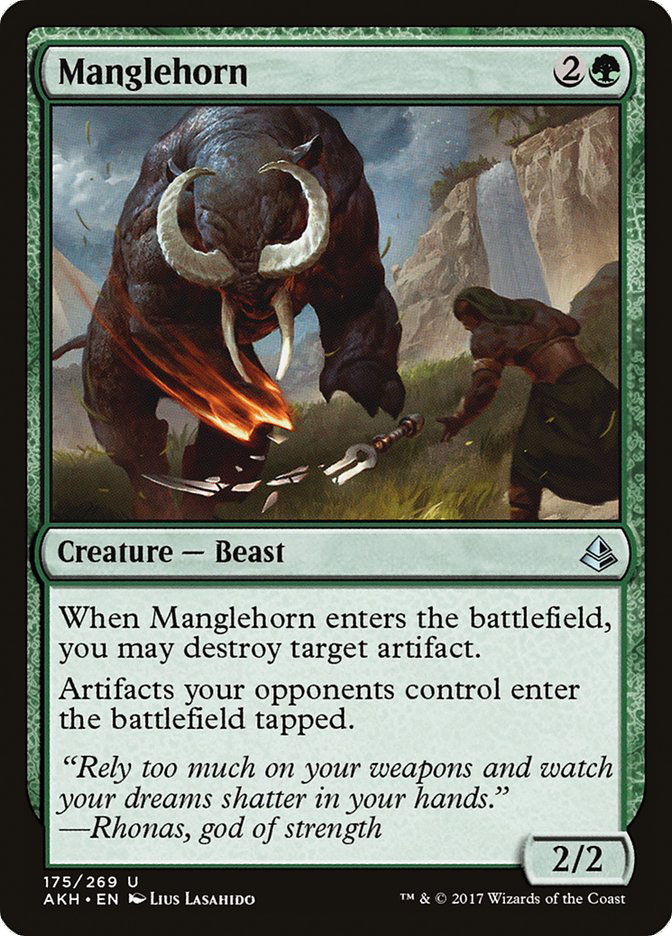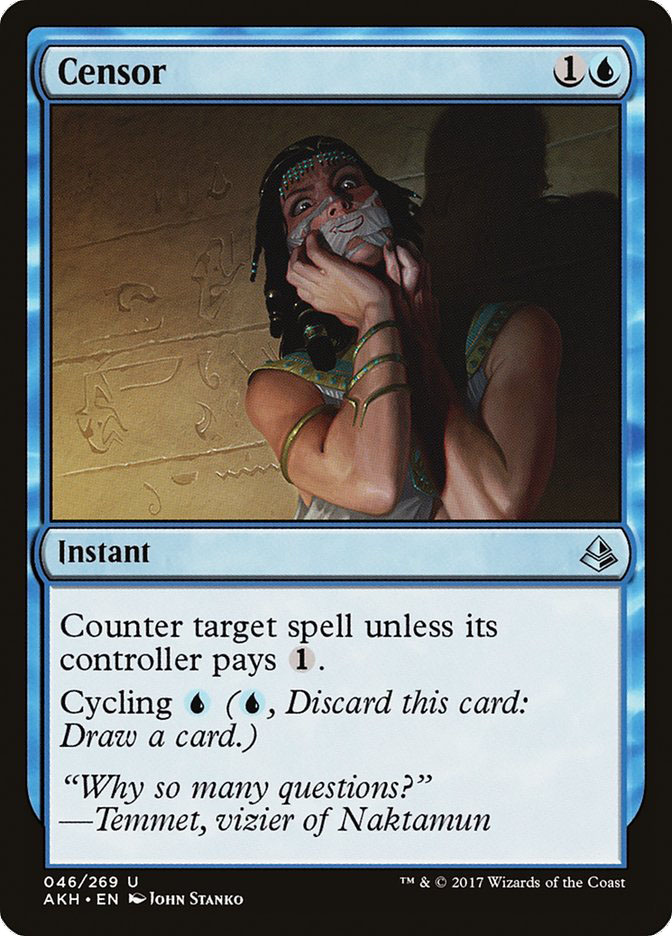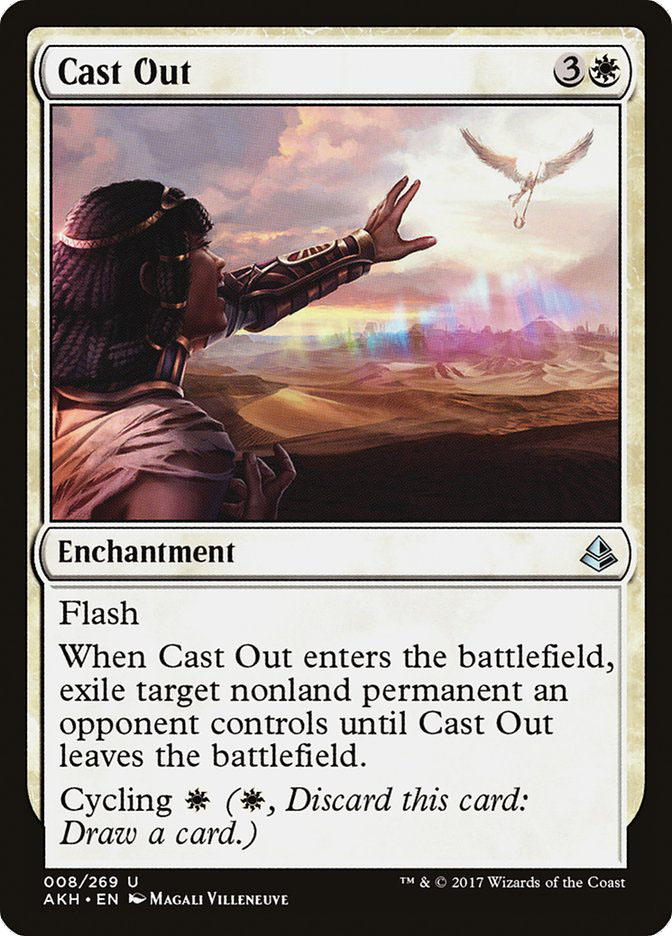As of this writing, 126/269 cards of Amonkhet have been previewed, and I’ve already got a lot to share.
You’re probably going to notice a few themes throughout many of my decks. One is that cycling is the most prominent mechanic I’m showcasing, for two big reasons:
I already started to get into building Drake Haven decks last week, but Curator of Mysteries is a ridiculous card and probably my front-runner for favorite card of the set. A four mana 4/4 flier with a reasonable value ability likely doesn’t excite most folks in 2017, but there’s a lot of subtle play hiding in the Curator’s text box.
The reality is that I expect to cycle this card more than 50% of the time. Your natural question might then be, “Why are you so excited about this marginal velocity card that’s sometimes a creature?”
The answer is similar to the auspicious nature of Thraben Inspector. It didn’t look all that impactful, but we now know that Inspector is arguably (and I’ll argue yes) the best creature in Standard. Standard is all about living and dying by your curve in order to establish a reasonable battlefield presence in the early game to combat the planeswalker terrors of Mardu and Four-Color Saheeli. You absolutely cannot allow opposing planeswalkers to generate traction against you if you hope to win the majority of your games.
As a result, Curator of Mysteries can be cycled easily in the early game when you have mana to sink or need to dig for a land drop, but it can also just be played on turn 4 to “fix” your curve and threaten planeswalkers. A 4/4 flier is a great combatant against opposing Gideons, and don’t let the Sphinx’s seemingly innocent ability fool you; we should all know by now that a well-timed scry or two can be a full card of value. Later in the game, Curator is a worthy draw and a full-blown threat. Any further cycling cards you draw should turbo-charge you towards out-topdecking your opponent.
All of this aside, Curator of Mysteries is going to be the central point of several Standard engines. A one-mana cycling card that happens to be a creature has a wide range of implications, even if you aren’t aware of them yet. Don’t worry, though. We’ll get to some of them shortly, and we only have about half the set revealed!
The second thing you’re likely to notice about the decks today is the widespread inclusion of this (also perhaps seemingly inconspicuous) creature:
We all know that Heart of Kiran, Walking Ballista, and assorted Clues are a huge part of Standard right now, which makes Manglehorn a fairly attractive card against Mardu Vehicles.
What is a little more difficult to catch at first glance is that Manglehorn also stops the Saheeli Rai combo. It’s never really been a point of discussion until Manglehorn’s printing, but the copies generated from Saheeli are artifacts, meaning they cannot attack as they enter the battlefield tapped.
As a result, this three-mana “hate card” is effective against the “big two” from last Standard season. It is a worthy card to play in maindecks and will have vast implications about how the Standard format will be shaping up moving forward.
Is it easy to remove? Yes, but it’s still a piece of interaction to keep Four-Color Saheeli off-balance. As we’ve seen with Walking Ballista, any of kind of reasonably cheap card to cast that gets on the battlefield and forces Four-Color Saheeli to spend a turn or spell to remove in order to be able to combo safely is a big deal.
An Aside on Amonkhet
Cycling really excites me, as it is the type of mechanic that encourages players to actually hit their land drops and play games of Magic. I love that it’s returning. However, the strongest implication out of Amonkhet to me is a return to honest but powerful answers and build-around cards being incorporated into the format over cards that just ooze raw stats.
No one should ever feel bad about these cards being cast against them or being incorporated into their opponents’ decks.
Cards like Drake Haven are certainly powerful, but they take effort to enable and encourage immersive deckbuilding, not dying in three turns to a spread seven power from a difficult-to-answer planeswalker.
Maybe this set isn’t as splashy on the surface with a clear “must-buy” card, but that’s a good thing.
Amonkhet looks fun.
(Editor, yeah, I broke a rule here.) [You do you, kid. -Ed.]
End Aside – and Decklists
Creatures (18)
Lands (25)
Spells (17)

Usually when I build new decks, It’s pretty easy for me to tell if something has potential initially or whether it will be just about “checking” to see if an interaction is good before beginning a tuning process or moving on. The latter is something I’ll show off next, but this Crush of Tentacles deck is really difficult for me to evaluate.
Is Shefet Monitor good? I don’t know. The price is certainly steep, but it plays very well in this deck by curving naturally into Crush of Tentacles and playing great with New Perspectives once your gameplan is online. Even just its “bad mode” as a generic Craw Wurm impersonation is theoretically fine once you’ve set up and have a ton of mana.
I’ve already touched on it, but you’ll notice that I have a lot of failsafes incorporated into my deck against Four-Color Saheeli; I’m looking to build actual playable decks in this already hostile format. The fact that I can incorporate new cards in old strategies and look to be fairly well-insulated against the big two is an awesome feeling for how this new Standard format is shaping up.
Finally, Oath of Nissa is just great with Curator of Mysteries and potentially more powerful cycling creatures that get printed.
Creatures (27)
- 4 Servant of the Conduit
- 1 Trophy Mage
- 4 Greenbelt Rampager
- 4 Druid of the Cowl
- 4 Hidden Herbalists
- 4 Walking Ballista
- 4 Channeler Initiate
- 2 Manglehorn
Lands (20)
Spells (13)

This deck may not be currently functional, but it’s something worth trying. I noted last week that the Monuments were very interesting to me, as all cost reduction is. If Hazoret’s Monument is potentially the most powerful in terms of ability, Rhonas’s looks to be the best at actually enabling broken draws.
Essentially this deck hopes to generate a lot of mana, draw a bunch of cards, and “rummage” through its deck. With Paradox Engine online you can go pretty wild, most notably with Greenbelt Rampager, and your bevy of creature spells should enable some arbitrarily large monster with trample to get through or a ton of mana to get sunk into Walking Ballista for a kill.
Hidden Herbalists is certainly the largest benefactor of actually costing less mana, but all of these mana creatures only costing G is potentially something to look out for.
Creatures (15)
- 1 Ishkanah, Grafwidow
- 1 Noxious Gearhulk
- 4 Servant of the Conduit
- 3 Walking Ballista
- 4 Felidar Guardian
- 2 Manglehorn
Planeswalkers (5)
Lands (22)
Spells (18)

I tried and failed with a similar experiment, B/G Delirium “splashing” the combo off Oath of Nissa, in current Standard, but I think it’s worth taking another look at now with Liliana, Death’s Majesty.
The new Liliana’s interaction with Felidar Guardian and the ability to “re-loop” all of them on a single turn is legitimately powerful.
Cast Out is also just an awesome card in any kind of Delirium shell, although ironically this deck already has a large amount of enchantments.
The biggest problem here is that the deck is just so difficult to build. What creatures and bullets should you play? Is Vessel of Nascency actually where you want to be? Should you butcher the manabase to allow “hard-casting” Saheeli? It’s all difficult to gauge.
Creatures (9)
Lands (21)
Spells (30)

This deck is templated from old Aetherworks decks with a straightforward plan – stall out and win the game. Only the second copy of Approach of the Second Sun needs to be played from hand, so Aetherworks Marvel can theoretically cast the first and then sift through the top six, leading directly to a victory.
Approach of the Second Sun is also reasonably easy to actually cast, so while it certainly isn’t as powerful on the front-end as Ulamog, the Ceaseless Hunger in terms of being a “turn 4” deck, I suspect that it is stable.
I’ve actually included a sideboard here, since it’s also fairly easy to template and shows off Glorybringer for what I believe it to be – a great sideboard plan.
This deck is weak to countermagic and similar interaction Game 1, so it makes a lot of sense to transform into the older creature/planeswalker plan, and I believe Glorybringer to be a great way to facilitate playing “fair.”
Creatures (17)
- 2 Ayli, Eternal Pilgrim
- 2 Archangel Avacyn
- 4 Thraben Inspector
- 2 Thalia, Heretic Cathar
- 3 Sram, Senior Edificer
- 4 Walking Ballista
Planeswalkers (4)
Lands (24)
Spells (15)

Probably my most boring deck today, but I think it showcases a valuable lesson. I certainly believe Cartouches and various engine cards in Amonkhet to be viable – and Trial of Ambition in particular looks great to me since it is so cheap, but it is important to actively play good cards in your deck as well.
Going overboard on these small-ball value engines starts to add up in terms of mana costs, which is why I believe the white Cartouche to be the best. Its synergy with Sram, Senior Edificer looks legitimately great to me, and I could see Trial of Solidarity enabling some linear go-wide strategies as well.
Creatures (22)
- 4 Prized Amalgam
- 4 Stitchwing Skaab
- 4 Elder Deep-Fiend
- 4 Advanced Stitchwing
- 2 Hazoret the Fervent
- 4 Curator of Mysteries
Lands (22)
Spells (16)

This is probably the closest deck I have to a generic update, but Drake Haven gives Emerge decks another huge angle of attack. It was often difficult for these decks to generate enough meaningful pressure without finding Prized Amalgams, but now returning a Stitchwing Skaab with Drake Haven on the battlefield represents seven points of power!
Hazoret the Fervent plays great in this strategy too, as the deck often wants to be hellbent and the God is a great follow-up to an Elder Deep-Fiend tap on an opponent’s end step.
Further, Hazoret is also meaningful resistance against the Saheeli combo with its damage ability and is far more difficult to remove than something like Walking Ballista.
Creatures (20)
- 2 Archangel Avacyn
- 4 Thraben Inspector
- 1 Thalia, Heretic Cathar
- 4 Spell Queller
- 4 Scrapheap Scrounger
- 3 Walking Ballista
- 2 Curator of Mysteries
Planeswalkers (4)
Lands (24)
Spells (12)

Failure//Comply is a card I like that may just be unplayable. What this U/W deck is exceptionally good at, however, is obtaining and maintaining Gideon advantage.
Comply is a huge follow-up to either your Gideon or Curator on the fifth turn, and that turn cycle of reprieve may be all that is necessary to get a stranglehold on the game. That said, this deck is likely not great at playing from behind, and without any real forms of card advantage, it might be difficult to wrestle back control in longer contests.
Creatures (19)
Lands (22)
Spells (19)

The best (at least coolest) for last. This a dramatic example of what is possible once you start including cycling in Standard. Cheap creatures and Ongoing Investigation make for a super-powerful grinding engine that also keeps you alive. Cracking Clues can generate additional velocity or pair with Inspiring Statuary to start going wild, and once you’ve assembled Tamiyo’s Journal plus New Perspectives, it’s hard to imagine that your opponent is going to live much longer before succumbing to an army of Drakes or a very angry awakened land.
Is anything going to be possible, or are we going to be stuck in a two-deck rut for the next couple of months? We’re only halfway through the set and I’m already itching to start playing. Amonkhet looks exciting and impactful. I’m willing to bet that Standard is ready to start changing for the better.


